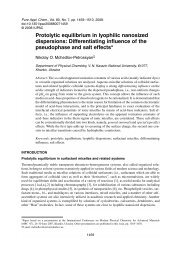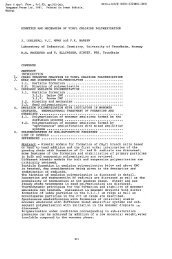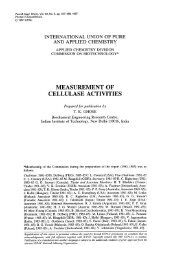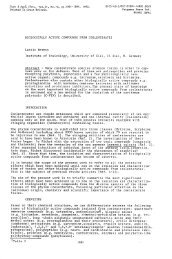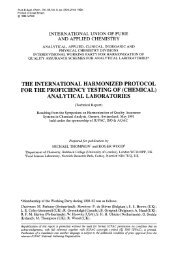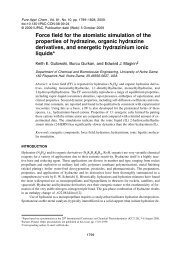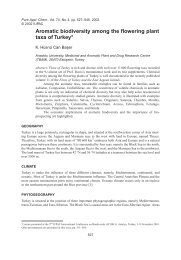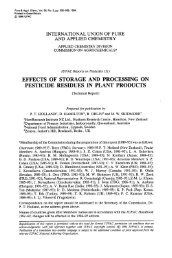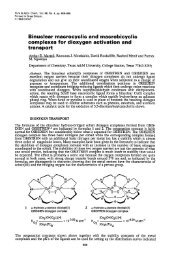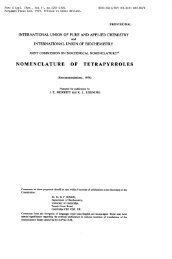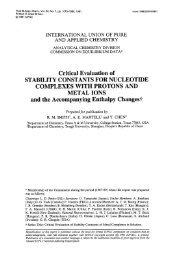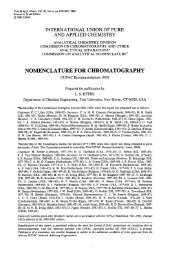The echurian worm Bonellia viridis has attracted the ... - IUPAC
The echurian worm Bonellia viridis has attracted the ... - IUPAC
The echurian worm Bonellia viridis has attracted the ... - IUPAC
Create successful ePaper yourself
Turn your PDF publications into a flip-book with our unique Google optimized e-Paper software.
Pure & Appi. Chem., Vol. 51, pp. 1847—1864.<br />
Pergamon Press Ltd. 1979. Printed in Great Britain.<br />
THE STRUCTURE AND PHYSIOLOGICAL ACTIVITY OF BONELLIN - A UNIQUE<br />
CHLORIN DERIVED FROM BONELLIA VIRIDIS<br />
L. Agius1, J.A. Ballantine2, V. Ferrito1, V. Jaccarini1, P. Murray—Rust3,<br />
A. Pelter2*, A.F. Psaila1' and P.J. Schembri<br />
<strong>The</strong> <strong>echurian</strong> <strong>worm</strong> <strong>Bonellia</strong> <strong>viridis</strong> <strong>has</strong> <strong>attracted</strong> <strong>the</strong> attention of both biologists<br />
and chemists over a long period of time. A drawing of <strong>the</strong> female organism is shown in Fig 1.<br />
<strong>The</strong> animal is a deep green all over its surface and is negatively phototactic. <strong>The</strong> trunk of<br />
<strong>the</strong> animal is generally housed in a burrow system and <strong>the</strong> proboscis is extended for feeding<br />
purposes.<br />
<strong>Bonellia</strong> <strong>viridis</strong> Rol. (female)<br />
Fig. 1<br />
<strong>The</strong>re are several points of interest regarding this organism. <strong>The</strong> first is <strong>the</strong> mark-<br />
ed sexual dimorphism: <strong>the</strong> female is much larger than <strong>the</strong> male which is only 1 — 3 nnn long.<br />
<strong>The</strong> males live parasitically inside <strong>the</strong> female after an initial period of settlement on <strong>the</strong><br />
proboscis. <strong>The</strong>re are usually several rnLes in each female. <strong>The</strong> eggs hatch into sexually<br />
undifferentiated larvae. It <strong>has</strong> been repeatedly observed that if <strong>the</strong> indifferent larvae<br />
settle on a female <strong>the</strong>y differentiate into males, whilst if <strong>the</strong>y settle away from <strong>the</strong> female<br />
<strong>the</strong>y develop into females. Thus it is clear that an exogenous agent is influencing <strong>the</strong> det-<br />
ermination of <strong>the</strong> sex of <strong>the</strong> larvae, ra<strong>the</strong>r than this being wholly determined genetically.<br />
<strong>The</strong> larvae seem to be specially <strong>attracted</strong> to <strong>the</strong> proboscis of <strong>the</strong> female on which<br />
<strong>the</strong>y settle. When <strong>the</strong> larvae leave <strong>the</strong>ir site of attachment on <strong>the</strong> female, <strong>the</strong>y leave behind<br />
a clear area from which all pigment <strong>has</strong> been removed,4 something we have been unable to<br />
achieve by chemical extraction. This removal of pigment suggests that it is being actively<br />
taken up by <strong>the</strong> larvae and raises <strong>the</strong> question of whe<strong>the</strong>r or not <strong>the</strong> pigment <strong>has</strong> anything<br />
to do with <strong>the</strong>ir masculinisation. Such a question is also raised by <strong>the</strong> observation that<br />
<strong>the</strong> degree of masculinisation depends on <strong>the</strong> length of contact between <strong>the</strong> adult and larvae,<br />
* Lecture delivered by Professor A. Pelter.<br />
1847
1848<br />
L. AGIUS et al.<br />
'fairly short contact times resulting in intersexes.5 Ano<strong>the</strong>r observation of some interest<br />
is that irritation of <strong>the</strong> adult female produces a green secretion with potent masculinising<br />
4,6<br />
properties.<br />
Naturally <strong>the</strong> proboscis is relatively vulnerable to attack, but in general is left<br />
unmolested. We have shown4 that <strong>the</strong> flesh of B.<strong>viridis</strong> is highly unpalatable to a wide<br />
range of small predators. Thus B.<strong>viridis</strong> affords good material for <strong>the</strong> study of chemical<br />
products with marked biological activity.<br />
A history of <strong>the</strong> study of <strong>the</strong> extracts from B.<strong>viridis</strong> is shown in Fig.2.<br />
History of <strong>Bonellia</strong> <strong>viridis</strong> Extracts.<br />
1874 E.R. LANKESTER : Obtained a green extract of <strong>the</strong> <strong>worm</strong>s in sea water.<br />
1875 H.C. SORBY : Obtained a visible spectrum of an alcoholic solution.<br />
Not chlorophyll.<br />
1928 F. BALTZER Showed that <strong>the</strong> extract had masculinising properties and was<br />
toxic to a variety of marine larvae.<br />
1931 F. MICHEL : Suggested that extract was a chemical defence mechanism.<br />
1939 E. LEDERER : Obtained crystalline pigment from extracts. C31H362N4O4<br />
—<br />
Made methyl ester, Zn, Cu and Fe complexes.<br />
Visible spectrum almost identical to mesopyrrochlorin<br />
(C31H36N402).<br />
Suggested that pigment was a dioxymesopyrrochlorin formed by<br />
breakdown of chlorophyll.<br />
1955 R. LALLIER : Showed that <strong>the</strong> extract immobilised sea urchin sperm and was<br />
lethal at higher concentrations.<br />
<strong>The</strong> toxic effects were enhanced by light.<br />
<strong>The</strong> green pigment was reponsible for <strong>the</strong> toxicity.<br />
1962 R.F. NIGRELLI : <strong>The</strong> extracts were effective in inhibiting <strong>the</strong> growth of many<br />
cellular organisms including oral carcinoma at 5 p.p.m. in<br />
tissue culture.<br />
Fig. 2.<br />
Over 100 years ago, Sorby7 studied <strong>the</strong> spectrum of an ethanol extract of B.<strong>viridis</strong><br />
and showed that <strong>the</strong> green pigment was not chlorophyll. Incidentally in this paper, he first<br />
defined on bonellin, <strong>the</strong> use of <strong>the</strong> millimicron for <strong>the</strong> measurement of wavelength and for<br />
<strong>the</strong> plotting of spectra.8<br />
<strong>The</strong> first real chemical work was carried out by E. Lederer who obtained a cryst-<br />
alline green pigment from <strong>the</strong> extracts. <strong>The</strong> visible spectrum was almost identical to that<br />
of mesopyrrochlorin (see Fig.6), this being most significantly a chlorin lacking a C—15<br />
substituent and with only simple alkyl or hydrogen substituents at all o<strong>the</strong>r positions of<br />
<strong>the</strong> chlorin system. Lederer was able to suggest an empirical formula for <strong>the</strong> pigment, as<br />
well as making various derivatives. As bonellin had two more oxygen atoms than mesopyrro—<br />
chlorin, Lederer made <strong>the</strong> tentative suggestion that bonellin retained two oxygen atoms at<br />
C—13 and C—l5, <strong>the</strong>se being derived from <strong>the</strong> oxidation of <strong>the</strong> carbocyclic ring of chloro—<br />
phyll.* Over a period of time this preliminary suggestion assumed <strong>the</strong> status of a proof,<br />
and <strong>the</strong> formula gained such acceptance that bonellin was treated as a fully characterised<br />
natural product.1° However, a brief reading of <strong>the</strong> literature shows that <strong>the</strong> spectrum<br />
* . .<br />
<strong>IUPAC</strong> numbering for porphyrins is used throughout. cf. Formula 1.
<strong>The</strong> structure and physiological activity of bonellin 1849<br />
observed and <strong>the</strong> suggested structure are incompatible with each o<strong>the</strong>r inasmuch as oxygen<br />
substituents at C—13 and, in particular at C—15, would be expected to profoundly modify <strong>the</strong><br />
simple chlorin spectrum of mesopyrrochlorin)'12 Thus <strong>the</strong> accepted structure for bonellin<br />
was undoubtedly incorrect and in view of <strong>the</strong> high interest in <strong>the</strong> possible physiological<br />
properties of bonellin 13, a re—investigation was felt to be in order.<br />
All our B. <strong>viridis</strong> were collected from Marsalokk bay on <strong>the</strong> Maltese coast. As <strong>the</strong><br />
proboscides are easy to collect, and can regenerate, it was decided to concentrate initially<br />
on <strong>the</strong> pigment collected from this portion of <strong>the</strong> animal.14 <strong>The</strong> proboscideswere macerated<br />
in ethanol to give a solution with a spectrum virtually identical to that of pure bonellin.<br />
<strong>The</strong> extraction procedure for bonellin and dimethyl bonellinate is shown in Fig. 3. In <strong>the</strong><br />
event, bonellin dimethyl ester (BDNE) proved to be purer than <strong>the</strong> 'pure' bonellin and hence<br />
isolation was concentrated on <strong>the</strong> former. Bonellin was produced from <strong>the</strong> ester by simple<br />
hydrolysis, and it was this material that was used in our biological assays.<br />
BONELLIA VIRIDIS PROBOSCIDES<br />
Macerate in<br />
4<br />
EtOH/H20 GREEN SOLUTION<br />
4<br />
E<strong>the</strong>r extract<br />
GREEN ETHER SOLUTION<br />
4 1% NH4OH<br />
DEEP GREEN AMMONIA EXTRACT<br />
4<br />
GREEN ETHER EXTRACT<br />
4 6Z<br />
BLUE ACID EXTRACT<br />
4<br />
BLUE DICHLOROMETHANE EXTRACT<br />
4 Water<br />
GREEN DICHLOROMETHANE EXTRACT<br />
Absorb onto MgCO3 column andextrude. Esterify +<br />
MeOH/H2SO4.<br />
Dissolve in acid and solvent extract. Chromatograph on neutral<br />
silica and monitor fractions<br />
I<br />
with HPLC on Pellosil.<br />
+<br />
BONELLIN (PURE)<br />
Fig. 3<br />
DIMETHYLBONELLIN (PURE)<br />
BDNE had an intense molecular ion at m/e 554.2928 ± 0.004 corresponding to<br />
C33H38N4O4, a formula in line with <strong>the</strong> elementary analysis (Fig. 4). Bonellin itself was<br />
<strong>the</strong> corresponding diacid of formula C31H34N404 (Fig. 4)l4 Various metal derivatives both<br />
of bonellin and BDME were made and had spectra differing strongly both from bonellin and <strong>the</strong><br />
crude extracts from B.<strong>viridis</strong>. Thus, at this early stage a most unusual feature of bonellin<br />
emerged. Itis a naturally occurrirg chlorin uncomplexed to any metal.15 As far as we can<br />
tell from examination of <strong>the</strong> spectrum of <strong>the</strong> crude extract, this is <strong>the</strong> way in which <strong>the</strong><br />
material occurs in <strong>the</strong> animal. Ethanol treatment is certainly not sufficient to destroy any<br />
of <strong>the</strong> metal complexes that we have made. It must be stated that our BDME is always contam-<br />
inated by ca 1% of <strong>the</strong> copper derivative and ca 0.01% of <strong>the</strong> iron derivative. <strong>The</strong>se may be<br />
present naturally but are more probably produced by extraction from <strong>the</strong> solvents used, as
1850 L. AGIUS et al.<br />
bonellin readily complexes with copper and iron. In addition to simple derivatives a com-<br />
pound, anhydrobonellin, with an extra carbocyclic ring, was prepared toge<strong>the</strong>r with its<br />
derivatives (Fig. 5). <strong>The</strong> relationship of various bonellin derivatives to bonellin is shown<br />
in Fig. 5.<br />
BONELLIN<br />
BONELLIN DINETHYL ESTER<br />
BONELLIN DIMETHYL ESTER Zn COMPLEX<br />
BONELLIN DIETHYL ESTER<br />
ANHYDRO-BONELLIN<br />
ANHYDRO-BONELLIN METHYL ESTER<br />
%<br />
ELEMENTAL MICROANALYSES<br />
Carbon % Hydrogen % Nitrogen<br />
found requires found requires found requires<br />
BONELLIN 70.5 70.7 6.5 6.5 10.6 10.6<br />
DIMETHYLBONELLIN 71.3 71.5 7.0 6.9 10.4 10.1<br />
DIETHYLBONELLIN 72.4 72.1 7.6 7.3 9.3 9.6<br />
BONELLIN DERIVATIVES<br />
C31H34N404<br />
C33H38N404<br />
C33H36N4O4Zn<br />
C35H42N404<br />
C31H32N403<br />
C32H34N403<br />
Fig. 5.<br />
B + 2CH2<br />
B + 2CH2 — 2H + Zn<br />
B + 2C2H4<br />
B - H20<br />
B — H20 + CH2<br />
<strong>The</strong> absorption spectrum of bonellin is shown in Fig. 6 and compared with <strong>the</strong> spectra<br />
of known porphyrins and chlorins (for each column <strong>the</strong> formula drawn is <strong>the</strong> full structure of<br />
<strong>the</strong> compound immediately beneath bonellin). Clearly bonellin is a chlorin and <strong>the</strong> relation-<br />
ship to mesopyrrochlorin (bottom of right hand column) on <strong>the</strong> basis of <strong>the</strong> spectra is very<br />
clear. Any formula proposed for bonellin must take this into account.<br />
640<br />
Bonet in<br />
EM<br />
M/\E<br />
Fig. 4.<br />
Bonellin<br />
M/E<br />
L J6 pH<br />
rM3'\E<br />
________ M\ /M ________<br />
Liv' :<br />
L0<br />
L2<br />
MeO2C<br />
OHS, M<br />
M7 \E<br />
M/\E<br />
M\ /M<br />
p CO2Me<br />
NH N<br />
CO2Me<br />
Fig. 6.<br />
LJ\J47<br />
Mesopyr<br />
[roddorin54O<br />
MO2C<br />
YE<br />
H) 'M<br />
CO2Me<br />
C31H34N404<br />
C33H38N404<br />
C35H42N404
<strong>The</strong> structure and physiological activity of bonellin 1851<br />
<strong>The</strong> C.D. curve for BDME shows that it is optically active* (Fig. 7).<br />
<strong>The</strong> 1H n.m.r. of bonellin revealed some unusual features as compared with some model<br />
chlorins and with deuteroporphyrin IX dimethyl ester (Table I, Fig. 8). Instead of <strong>the</strong><br />
usual doublet at T8.28 indicative of <strong>the</strong> l8a methyl group, <strong>the</strong>re are a pair of sharp sing—<br />
le at T7.88 and 8.20. A—dimethyl grouping in <strong>the</strong> reduced ring of <strong>the</strong> chlorin can be<br />
inferred and this was confirmed in that irradiation of <strong>the</strong> multiplet stretching from T7.2—<br />
8.1 (Fig. 8,9) (l7a CU2, l7b CU2) reduced <strong>the</strong> triplet at T5.6 due to H—l7 to a singlet.<br />
Hence H—l7 cannot be adjacent to any ring carbon atoms bearing a proton and sub—unit (i)<br />
(Fig. 10) is defined. Such a unit is known for vitamin B12 but is unique in chlorin chemistry.<br />
Clearly bonellin contains no vinyl subs tituents and <strong>has</strong> four meso protons in two<br />
groups of two at 0.34, 0.44 and 1.09 and 1.22. <strong>The</strong> positions are similar to those of known<br />
chlorins16 but unlike all natural chlorins related to chlorophyll, bonellin lacks a sub—<br />
stituent at C—l5, this being ano<strong>the</strong>r unique feature of <strong>the</strong> molecule. A noteworthy point is<br />
<strong>the</strong> appearance of two low field protons at 1.30 and 1.18 allylically coupled to two of <strong>the</strong><br />
three 'aromatic' methyl groups at T6.52 — 6.56. <strong>The</strong> position is strikingly like that of<br />
deuteroporphyrin IX dimethyl ester (DPME) (Fig. 9). Figure 9 also shows some decoupling<br />
experiments relating H—l7, H—17a and H—17b and also similar experiments that delineate an<br />
'aromatic' propionate group at C—13, as in most naturally occurring porphyrins. <strong>The</strong>se<br />
signals toge<strong>the</strong>r with <strong>the</strong> remaining 'aromatic' methyl singlet define <strong>the</strong> standard sub—unit<br />
(ii) toge<strong>the</strong>r with <strong>the</strong> sub—units (iii) and (iv) (Fig. 10) which are unique in naturally<br />
occurring chlorins.<br />
.12<br />
.8<br />
-12<br />
248 275<br />
We thank Dr. M. Scopes of Westfield College, London for this spectrum.<br />
643<br />
C.D. curve for DIMETHYLBONELL1N<br />
Fig. 7.<br />
nm
1852 L. AGIUS et al.<br />
H<br />
HH<br />
PROTOPORPHYRDMETHYL<br />
MeOC CO2Me<br />
TABLE I<br />
18 n.m.r. (CDC13,r) of BDME and related compounds<br />
SIDEI21AINS<br />
2a<br />
BDME<br />
6.58<br />
Deuteroporhyrin<br />
IX D8<br />
6.54<br />
Chlorin<br />
e6<br />
(6.47<br />
Isochloçin<br />
e4 DME1<br />
(6.40<br />
7a 6.61 6.60<br />
H- HN.4H<br />
MeOC<br />
CO2Me<br />
(I)<br />
<strong>The</strong> structure and physiological activity of bonellin<br />
DEUTEROPORPHYRIN LX DIMETHYL ESTER<br />
C31<br />
______________________ A _____________ VA<br />
A<br />
0 1 2 3 4 5 6 7 8 9 p- 10 14 15<br />
BONELLIN DIMETHYL ESTER<br />
111.... t.<br />
t 1<br />
Fig. 9<br />
I,<br />
NH<br />
CH2<br />
CO2CH3 \ CH3<br />
CH2CO2CH3<br />
(ii)<br />
Fig. 10.<br />
I<br />
HXt<br />
CH3<br />
(iii) (iv)<br />
<strong>The</strong> sub—units (i) — (iv) can be assembled via <strong>the</strong> four meso—CH atoms, in a large<br />
variety of ways, none of which shows any very close relationship to chlorophyll, <strong>the</strong> parent<br />
of o<strong>the</strong>r known chlorins. In order to preserve a biogenetic relationship between bonellin<br />
and known naturally occurring porphyrins and chlorins, we confined our structural formulations<br />
to type III porphyrins. On this basis, BDME can be formulated as ei<strong>the</strong>r (lb) or<br />
(2b), formally corresponding to <strong>the</strong> addition of methane across <strong>the</strong> peripheral positions<br />
of ei<strong>the</strong>r ring D or C of deuteroporphyrin IX dimethyl ester. Bonellin itself would, of<br />
course, correspond to ei<strong>the</strong>r (la) or (2a).<br />
IL<br />
1853
1854 L. AGIUS et al.<br />
H_. H Me1'1004")— H<br />
M96 E<br />
93 104<br />
0M<br />
C02M<br />
E.
<strong>The</strong> structure and physiological activity of bonellin<br />
TABLE II<br />
n.m.r. of BDME and related COIUPOUfldS.a<br />
SID.EcNAINS BDME Deuteroporphyrin IX Chlorin esters1"1'2<br />
DME<br />
2a 13.4 13.4 10.8 — 12.0<br />
7a 13.4 13.4 10.7 — 11.3<br />
12a 11.2 11.3 11.7 — 12.3<br />
18a(cis)<br />
18a(trans)<br />
3a<br />
32.0<br />
23.4<br />
—<br />
[11.3<br />
—<br />
—<br />
22.7 — 23.4<br />
128.3 — 128.8<br />
3b — — 121.0 — 122.6<br />
Ba — — 18.1 — 19.4<br />
8b — — 17.1 — 19.2<br />
13a 21.5 21.5 —<br />
13b 36.6 36.7 —<br />
13c 173.8 or 174.2 172.8 —<br />
13d 51.5 or 51.7 51.4 —<br />
17a 31.8 21.5 30.8 — 31.2<br />
17b 27.6 36.7 29.5 — 31.3<br />
17c 173.8 or 174.2 172.8 172.4 — 172.8<br />
lid 51.5 or 51.7 51.4 51.2 — 51.5<br />
SATURATED' RING<br />
16 165.7 or 172.1 159.0 — 173.4<br />
17<br />
18<br />
57.8<br />
49.7<br />
Aromatic 28—144.2<br />
50.8 — 52.0<br />
49.2 — 50.0<br />
19 165.7 or 172.1 159.0 — 173.4<br />
AROMATIC RINGS<br />
3<br />
8<br />
1126.3<br />
l30.3<br />
130.2<br />
136.0<br />
1<br />
(,,l22.0 — 154.5<br />
l€S0<br />
5 J102.1 /98.7<br />
95.4 — 102.1<br />
10<br />
15<br />
\,102.5<br />
J<br />
'99.5<br />
101.7 — 105.9<br />
91.2<br />
f95.l<br />
925c<br />
20<br />
a)<br />
93.0<br />
91.8 —<br />
'196.2<br />
All spectra rwt in CDC13, chemical shifts in p.p.m. downfield from SiMe4.<br />
b) Wide range of chlorins1'2.<br />
c) trans—Octaethylchlorin as comparison to eliminate effects due to carbocyclic ring.<br />
1) R.J. Abraham, G.E. Hawkes and KM. Smith, J.C.S. Perkin II, 1974, 628. 2) KM. Smith<br />
and J.F. Unsworth, Tetrahedron, 1975, 31, 367.<br />
We attempted to distinguish between (1) and (2) by examining <strong>the</strong> chemical shifts of<br />
<strong>the</strong> C—5 and C—b carbon atoms of BDME, which do not correspond well with those of<br />
octaethylchborin (Table II). For porphyrins, it <strong>has</strong> recently been shown that meso—carbon<br />
atoms flanked by two protons give rise to signals in <strong>the</strong> 13C n.m.r. at ca 104 p.p.m.<br />
compared with ca 96 p.p.m. when flanked by two simple alkyl groups18. Fur<strong>the</strong>rmore, in<br />
deuteroporphyrin IX, <strong>the</strong> signals due to C—S and C—b are ca 3 — 3.5 p.p.m. downfield of<br />
C—15 and C—20 (Fig 11) and <strong>the</strong> same trend would be anticipated in <strong>the</strong> electronically similar<br />
chiorins (Fig 11).<br />
Comparison of <strong>the</strong> positions of <strong>the</strong> signals from <strong>the</strong> meso—carbon atoms of octaethyl—<br />
porphyrin and octaethylchborin gives an index of <strong>the</strong> corrections to be applied to <strong>the</strong> meso—<br />
positions of a porphyrin on saturating one of <strong>the</strong> four heterocyclic rings (Fig. 13). We<br />
took octaethylchborin ra<strong>the</strong>r than any chlorophyll derivative as our model compound as it<br />
lacked a C—lS substituent and also a carbonyl group attached to C—13 which we have shown<br />
in model experiments to strongly affect <strong>the</strong> signal due to C—b, <strong>the</strong> chemical shift of which<br />
is crucial to our argument (Fig 12).<br />
1855
1856<br />
H<br />
18a(trans)Me N HNII\ 12a<br />
liaCI4 i.a<br />
2<br />
ia<br />
L. AGIUS et al.<br />
H CH2CH2CO2R CO2R<br />
I 13a 13b 13c l3d<br />
CH2CO2R<br />
lib lic lid<br />
(1)<br />
(a) R=H; Bonellin<br />
(b) RMe;BDME.<br />
<strong>The</strong> n.m.r. of BDME is assigned as in Table II, assignments being supported by <strong>the</strong><br />
off—resonance spectrum. Signals for all <strong>the</strong> carbon atoms were observed and most could be<br />
specified by comparison with compounds of known structure. <strong>The</strong> 'aromatic' methyl groups at<br />
l2a, 2a and 7a appear at positions comprable with those of deuteroporphyrin IX as expected.<br />
Fur<strong>the</strong>rmore <strong>the</strong> unsubstituted ring atoms C—3 and C—8 of BDME appear at <strong>the</strong> corresponding<br />
positions with <strong>the</strong> correct multiplicity, thus confirming completely <strong>the</strong> structure of rings<br />
A and B. <strong>The</strong> saturated carbon atoms 0-17 and C—l8 (structure 1) appear at <strong>the</strong> expected<br />
postitions. Most importantly <strong>the</strong> signal assigned to C—18 remains a singlet in <strong>the</strong> of f—<br />
resonance spectrum, thus proving <strong>the</strong> presence of a gem—dimethyl grouping whilst that of<br />
C—17 becomes a doublet. <strong>The</strong> signals assigned to <strong>the</strong> propionate groups attached to <strong>the</strong><br />
reduced and non—reduced ring compare well with those for deuteroporphyrin IX and a wide<br />
range of chlorins.<br />
<strong>The</strong> —dimethyl carbon atoms gave resonances at 23.4 (18a, cis) and 31.8 p.p.m.<br />
(18a, trans). <strong>The</strong> shift in <strong>the</strong> position of <strong>the</strong> trans— methyl group was confirmed by<br />
single frequency decoupling experiments using <strong>the</strong> well separated frequencies of <strong>the</strong><br />
'aliphatic' methyl groups and is in line with <strong>the</strong> stereoassignments made to dicyanocobalin—<br />
17 13 .<br />
amide . Thus <strong>the</strong> C n.m.r. of BDME is in accord with structures (1) and (2).<br />
(2)
<strong>The</strong> structure and physiological activity of bonellin<br />
On this basis Fig. 13 shows <strong>the</strong> amendments needed for <strong>the</strong> values of <strong>the</strong> meso—carbon<br />
atoms in <strong>the</strong> conversion of a simple porphyrin to <strong>the</strong> corresponding chlorin. Also shown are<br />
<strong>the</strong> two possible sets of values for bonellin (structures (1) and (2)). In <strong>the</strong> case of<br />
structure (1) three of <strong>the</strong> four values are in line with those expected by applying <strong>the</strong><br />
increments for <strong>the</strong> appropriate positions (Fig. 11) to deuteroporphyrin IX DME. Indeed if<br />
<strong>the</strong> effect of a —dimethyl group upon an adjacent meso—carbon atom, which is unknown, is<br />
similar to that of a CH3—CH, <strong>the</strong>n all four values fit. However in <strong>the</strong> case of structure (2),<br />
<strong>the</strong>re is a meso—carbon atom at 102 p.p.m. between two flanking rnethy groups. This should be<br />
found at 98 — 99.5 p.p.m. and <strong>the</strong> gross discrepancy led us to favour (1) for bonellin14<br />
despite <strong>the</strong> fact that it is ring C that is modified in vitamin B12 as in (2).<br />
Naturally, as <strong>the</strong> spectroscopic investigations proceeded, we were attempting to obtain<br />
bonellin or one of its derivatives in a form suitable for X—ray analysis. Despite numerous<br />
attempts on many derivatives, none of <strong>the</strong> crystals obtained could be analysed. However, we<br />
had noticed that in <strong>the</strong> mass spectrum of bonellin <strong>the</strong>re was a peak corresponding to loss of<br />
water. It was thought that this could be due to a dehydrative cyclisation of a propionate<br />
unit onto an adjacent meso—carbon atom i.e. C—15)9 In an effort to emulate this reaction<br />
chemically, we dissolved bonellin in cold concentrated sulphuric acid, on which an irrevers-<br />
ible change in <strong>the</strong> spectrum occurred. <strong>The</strong> product, anhydrobonellin, was obtained in high<br />
1 13<br />
yield and purified as <strong>the</strong> monomethyl ester (ABME). On <strong>the</strong> basis of its H and C n.m.r.<br />
spectra,2° (Fig. 14) as compared with BDNE, it was clear that anhydrobonellin was derived<br />
specifically by cyclisation of <strong>the</strong> propionate group attached to C—l7 ra<strong>the</strong>r than <strong>the</strong> similar<br />
grouping at C—13.<br />
A summary of some of <strong>the</strong> spectral changes on passing from bonellin to anhydrobonellin<br />
is shown in Table III. Clearly it is <strong>the</strong> C—l7 propionate group that is involved in <strong>the</strong><br />
cyclisation.<br />
20 9 18 17 6 5 14 13 2 0 9 8 7 6 2<br />
Fig. 14.<br />
1857
1858<br />
L. AGIUS et al.<br />
TABLE Ill<br />
OBSERVED CHANGES OF NMR SPECTRA IN ANHYDROBONELLIN.<br />
ATOMS 1H (8-AB) *<br />
pp.m.<br />
13C (B-AB)<br />
p.p.m.<br />
13a + 0.25 - 1.9<br />
l3b - 0.11 + 1.0<br />
17 + 0.28 + 0.9<br />
17a - 0.20 - 7.2<br />
l7b - 0.30 + 6.0<br />
17c — - 26.6<br />
17d no signal no signal<br />
l8a cis - 0.11 - 2.9<br />
iSa trans + 0.34 + 3.9<br />
15 no signal - 11.1<br />
12a + 0.1 - 0.3<br />
* tentative assignments<br />
+ means shift to HIGH field in anhydrobonellin<br />
<strong>The</strong> absorption spectrum of anhydrobonellin compares well with that of anhydromeso—<br />
pyrrochlorin (Fig. 15) which we found had been made by Fischer many years before21 and<br />
anhydrobonellin and its monomethyl ester were assigned structures (3a) and (3b) on <strong>the</strong><br />
basis of (1) for bonellin.<br />
679<br />
Figs 15.<br />
Anhydrobonelli n<br />
A nhyd romesopyrrochlo nfl
<strong>The</strong> structure and physiological activity of bonellin<br />
(a) R= H Anhydrobonellin<br />
(b) R=Me,ABME<br />
A kinetic study of <strong>the</strong> dehydration carried out by Dr. P. Camilleri,* not only gave<br />
us its <strong>the</strong>rmodynamic parameters, but assured us that <strong>the</strong> reaction took place in one step<br />
without any intermediate stages. An X—ray study on a single crystal (unfortunately racemic)<br />
of ABME gave <strong>the</strong> result shown in Fig. 16, and confirmed in every detail <strong>the</strong> structure (3b)<br />
for ABME and hence (1) for bonellin.2° Ano<strong>the</strong>r view of ABNE is shown in Fig. 17. This<br />
(3)<br />
shows that one methyl group at C—l8 is almost at right—angles to <strong>the</strong> planar chiorin nucleus.<br />
Fig. 16<br />
* We thank Dr. P. Camilleri of <strong>the</strong> University of Malta for kindly supplying <strong>the</strong>se results.<br />
1859
1860 L. AGIUS et al.<br />
Fig. 17.<br />
We had observed that <strong>the</strong>re was present in <strong>the</strong> proboscis extract, a quantity (2E) of a<br />
pigment different from bonellin in chromatographic behaviour but with <strong>the</strong> same chromophore.<br />
Hence we examined <strong>the</strong> pigments of <strong>the</strong> body wall and viscera with <strong>the</strong> result shown in Table<br />
IV. (Peak 2 corresponds to <strong>the</strong> methyl ester(s) of <strong>the</strong> new pigment(s).) It can be seen<br />
that, in <strong>the</strong> body wall in particular <strong>the</strong>re is a high proportion of this new pigment.<br />
Body wall<br />
Probosces<br />
Viscera<br />
TABLE IV.<br />
Distribution of Pigments in B.<strong>viridis</strong>.<br />
Examination of <strong>the</strong> mass spectra of <strong>the</strong> purified material showed that it was a mixture<br />
of amides produced by conjugation of single a—aminoacids to <strong>the</strong> C—l7 propionic acid unit<br />
and that <strong>the</strong> parent compounds could be assigned structures (4)22 We were unable to separate<br />
<strong>the</strong> mixture, but hydrolysis gave bonellin and a mixture of a—amino—acids with <strong>the</strong> composition<br />
shown in Table V. This composition was confirmed and <strong>the</strong> configuration of <strong>the</strong> amino—acids<br />
assigned, by g. l.c. of <strong>the</strong> N-pentafluoropropionylamino—acid—(—)—3—methyl—2—butyl esters.23<br />
TABLE V.<br />
Amino-acid Cornppsition of Bone llin Conjugates.<br />
Amino—acid<br />
Valine<br />
Isoleucine<br />
Leucine<br />
No. of animals Wt. of purified<br />
material (mg)<br />
20<br />
20<br />
20<br />
Alloisoleucine<br />
of mixture Configuration<br />
<strong>The</strong> biological significance of <strong>the</strong>se amide conjugates of bonellin remains to be det-<br />
ermined. We have been informed by Dr. G. Prota (University of Naples) that he <strong>has</strong> independ-<br />
ently obtained <strong>the</strong> C—l7d isoleucine conjugate of bonellin as <strong>the</strong> main component of <strong>the</strong><br />
62.7<br />
23.0<br />
BDME<br />
pigment of <strong>the</strong> body walls of B.<strong>viridis</strong> collected from <strong>the</strong> sea near Naples.24<br />
5.9<br />
4.0<br />
57<br />
77<br />
0.5<br />
%<br />
Peak 2<br />
%<br />
50 50<br />
98 2<br />
L-<br />
L—<br />
L-<br />
71 29
<strong>The</strong> structure and physiological activity of bonellin 1861<br />
—CO2H<br />
Structure 4.<br />
Of course, as <strong>the</strong> chemical work was progressing a parallel biological programme was<br />
being carried out.25 As mentioned previously <strong>the</strong> larvae of B.<strong>viridis</strong> tend to settle on <strong>the</strong><br />
proboscis of <strong>the</strong> female, and in <strong>the</strong> closed conditions of our tanks 98% became male. After<br />
settlement on <strong>the</strong> female, male characteristics appeared within 2h, after 3 days <strong>the</strong>y were<br />
typical planariform males and after 6 days male differentiation was complete. Larvae isol-<br />
ated from <strong>the</strong> females, <strong>the</strong>mselves became female at a much slower rate e.g. 33% in 2 days,<br />
61% in 24 days and 78% in 31 days.<br />
<strong>The</strong> results of tests with bonellin ( 98.5% pure) are shown in Table VI.5 Clearly<br />
bonellin strongly increases <strong>the</strong> percentage of males, as compared with <strong>the</strong> pure sea—water<br />
control, though it is in no way as efficient as <strong>the</strong> adult female. This may be an effect<br />
of local concentration of active chemical or it may be that, in addition to bonellin, <strong>the</strong><br />
female produces o<strong>the</strong>r active material. <strong>The</strong>re would seem to be no question however that<br />
bonellin or its derivatives are involved in producing <strong>the</strong> masculinising effect, though <strong>the</strong><br />
results are somewhat batch sensitive.<br />
Table VI.<br />
Results of masculinisation experiments giving <strong>the</strong> % distribution of <strong>the</strong> various sexual<br />
differentiations of <strong>the</strong> indifferent larvae.<br />
Concentration<br />
of bonellin<br />
c<br />
U<br />
V<br />
(ui<br />
fl<br />
j<br />
.<br />
Indifferent<br />
1 ppm 64.6 19.1 12.1 3.0 1.0<br />
0.5 ppm 61.1 32.6 3.2 2.1 1.0<br />
0.2 ppm 77.3 6.2 8.2 7.2 1.1<br />
0.01 ppm 44.6 20.7 23.8 8.7 2.2<br />
With adult<br />
female<br />
Seawater<br />
con trol<br />
Me.<br />
H-<br />
IH<br />
1.0 1.0 98.0 0 0<br />
89.5 3.2 5.3 1.0 1.0
1862<br />
L. AGIUS et al.<br />
An effect we have studied in some depth is erythrocyte haemolysis. Fig. 18 shows<br />
that erythrocytes that have been exposed to bonellin in <strong>the</strong> dark or to pre-illuminated<br />
bonellin solutions in <strong>the</strong> dark do not lyse (even after periods much longer than shown in<br />
<strong>the</strong> Figure.) However erythrocytes which are exposed simultaneously to bonellin and light<br />
first swell, <strong>the</strong>n rapidly lyse. <strong>The</strong> action spectrum of bonellin coincides with <strong>the</strong><br />
absorption spectrum and whilst anhydrobonellin <strong>has</strong> some activity, copper bonellin <strong>has</strong> none.<br />
Fig. 18.<br />
Absence of oxygen in <strong>the</strong> atmosphere halves <strong>the</strong> rate of haemolysis and <strong>the</strong> effect of<br />
102 quenchers shows that singlet oxygen is active in <strong>the</strong> reaction.<br />
<strong>The</strong> results lead to <strong>the</strong> conclusion that nei<strong>the</strong>r bonellin nor its photo—oxidation<br />
pro(uct(s) are <strong>the</strong> active agents for lysis of erythrocytes. Possibly an unstable inter—<br />
riediate in <strong>the</strong> photo—oxidation (a hydroperoxide?) is <strong>the</strong> active agent and this problem is<br />
currently under investigation.<br />
TOTAL HAEMOLYS)S<br />
20 25<br />
Ttmo,mns.<br />
•rythrocyts suspsnstons sxpossd to 1O6M bonetttn and Ittuminated<br />
£. erythrocyt. suspinslons .xpos.d to t06M bonstttn but not ttumtnatsd<br />
0—0 erythrocyts suspsnstons tscktng bon.tttn and tttumtnatsd<br />
Suspensions of echinoid spermatazoa exposed to lO6M solutions of bonellin and<br />
illuminated for 15 mm., sediment on centrifugation. Examination showed <strong>the</strong>y were immobile<br />
and highly swollen and <strong>the</strong>y eventually died. Control suspensions illuminated in <strong>the</strong><br />
absence of bonellin or treated with bonellin in <strong>the</strong> dark or with pre—illuminated bonellin<br />
in <strong>the</strong> dark retained <strong>the</strong>ir normal shape, could be resuspended, and were highly active.<br />
(Table VII). Eggs also were strongly affected by a combination of bonellin and light, as<br />
was <strong>the</strong> development of fertilised eggs (Table VIII).
<strong>The</strong> structure and physiological activity of bonellin 1863<br />
Table VII.<br />
Effects of bonellin on fertilization of P.lividus eggs. In A <strong>the</strong> gametes were suspended<br />
in a 1.5 x 106M solution of bonellin in seawater and kept in total darkness for 10 mm<br />
before insemination. In B <strong>the</strong> gametes in bonellin solution were illuminated for 10 mm<br />
before insemination. In A and B <strong>the</strong> final concentration of bonellin in <strong>the</strong> mixed egg/sperm<br />
suspension was lO6M.<br />
Treatment of sperm or Conditions<br />
eggs in bonellin solution of<br />
before insemination fertilization<br />
A. (i) Non-illumin-ated<br />
sperm<br />
(ii) Non—illutnin—<br />
ated eggs<br />
B. (i) Illuminated<br />
sperm<br />
(ii) Illuminated<br />
eggs<br />
In <strong>the</strong> dark<br />
In <strong>the</strong> light<br />
In <strong>the</strong> dark<br />
In <strong>the</strong> light<br />
In <strong>the</strong> dark<br />
In <strong>the</strong> light<br />
In <strong>the</strong> dark<br />
In <strong>the</strong> light<br />
% eggs with fertilization<br />
membrane 1 hr after<br />
insemination<br />
60 — 80*<br />
10 — 30<br />
70 — 90<br />
5 — 30<br />
0 — 5<br />
0 — 5<br />
5 — 20<br />
0 — 5<br />
% eggs forming<br />
normal blastulae<br />
after 6 hr<br />
60 — 80*<br />
0<br />
70 —90<br />
0<br />
0 — 5<br />
0<br />
5 — 20<br />
0<br />
* Controls in which (a) <strong>the</strong> gamete suspensions in seawater lacking bonellin were illumin-<br />
ated from 10 mm before insemination till 6 hr afterwards; and (b) <strong>the</strong> gametes were kept in<br />
<strong>the</strong> dark for <strong>the</strong> same period; gave 70 — 90% formation of <strong>the</strong> fertilization membrane<br />
after 1 hr and 70 — 90% normal blastulae after 6 hr in both cases.<br />
Table VIII.<br />
Effects of adding bonellin to suspensions of fertilized P. lividus eggs at various times<br />
after insemination. Final concentration of bonellin in seawater,lO v1. Temperature 20°C.<br />
Illumination Time of addition Stage reached by at least 70% of eggs<br />
after addition of bonellin after 3 hr after 48 hr after<br />
of bonellin insemination inse mination insemination<br />
A. Absent<br />
B. Present<br />
0 mm<br />
15 mm<br />
45 mm<br />
75 mm<br />
120 mm<br />
o mm<br />
15 mm<br />
45 mm<br />
75 mm<br />
120 mm<br />
32-cell or later<br />
32-cell or later<br />
32-cell or later<br />
32-cell or later<br />
32-cell or later<br />
1-cell<br />
1-cell; abnormal 2-cell<br />
Abnormal 2-cell<br />
Abnormal 4- and 8-cell<br />
Abnormal 4- and 8-cell<br />
plute i<br />
plute I<br />
plutei<br />
plute I<br />
plutei<br />
1-cell<br />
1-cell; abnormal 2-cell<br />
Abnormal 2-cell<br />
Abnormal 4- and 8-cell<br />
Abnormal 4- and 8-cell<br />
'<strong>The</strong> developmental stages reached by fertilized P. lividus in normal seawater at 20°C were<br />
monitored at intervals after insemination and gave <strong>the</strong> following results:- 0, 15 and 45 mm,<br />
uncleaved; 75 mm, 2-cell, 120 mm, 4-cell; 3 hr, 32-cell or more advanced; 48 hr pluteus.
1864 L. AGIUS et al.<br />
Clearly <strong>the</strong> biochemistry of bonellin remains to be explored. In addition <strong>the</strong> photo—<br />
chemistry of this unique molecule must be investigated in depth. What is clear however is<br />
that a characteristic of organisms that is normally self—determined i.e. its sex, can be<br />
strongly influenced by an external and naturally produced chemical or chemicals. <strong>The</strong> mode<br />
of sex—determination in <strong>Bonellia</strong> is thus of general interest for <strong>the</strong> understanding of<br />
sexual differentiation in animals.<br />
REFERENCES<br />
1. University of Malta, Msida, Malta.<br />
2. University College of Swansea, Singleton Park, Swansea SA2 8PP.<br />
3. University of Stirling, Stirling, U.K.<br />
4. P.J. Schembri, M.Sc. <strong>The</strong>sis. University of Malta, 1977<br />
5. F. Baltzer, Revue Suisse Zool., 1931, 38, 361. K. Zwibuchen, Pubbl.Staz.Zool.Napoli,<br />
1937, 16, 28.<br />
6. L. Agius, M.Sc. <strong>The</strong>sis, University of Malta, 1978.<br />
7. H.C. Sorby, Quart.Journal.Microscop.Sci., 1875, 15, 166.<br />
8. J.A. Ballantine and A. Pelter, European Spectroscopy News, 1977, 11 5.<br />
9. E. Lederer, Compt.rend., 1939, 209, 528.<br />
10. G.Y. Kennedy, Ann.N.York.Acad.Sci., 1975, 244, 662.<br />
11. A.W. Johnson and D. Oldfield, J.Chem.Soc., 1965, 4303.<br />
12. R. Chong and P.S. Clezy, Austral.J.Chem., 1967, 20, 951.<br />
13. L. Schmarda, Dankschr.Akad.Wiss.Wien., 1852, 4, 121.<br />
E. Ray Lankester, Quart.J.Microscop.Sci., 1898, 40, 447; F. Baltzer, Handbuch der<br />
Zoologie, 1931, 2, 62 and refs <strong>the</strong>rein; h.Dhere and M.Fontaine, Ann.Inst.Ocean.,<br />
1932, 12, 349; R. Lallier, Compt.rend., 1955, 240, 1489; R.F.Nigrelli, M.F. Stempien,<br />
G.D. Ruggieri, V.R. Liguori and J.T. Cecil, Fed.Proc., 1967, 26, 1197.<br />
14. A. Pelter, J.A. Ballantine, V. Ferrito, V. Jaccarini, A.F. Psaila and P.J. Schembri,<br />
Chem.Coinm., 1976, 999.<br />
15. G.S. Marks, 'Heme and Chorophyll' Van Nostrand, London 1969.<br />
16. G.R. Collier, A.H. Jackson and G.W. Kenner, Chem.Comm., 1966, 299.<br />
17. A.I. Scott, C.A. Townsend, K. Okado, M. kafiwara, R.J. Cushley and P.J. Whitman,<br />
J.Amer.Chem.Soc., 1974, 96, 8069.<br />
18. R.J. Abraham, G.E. Hawkes and K.M. Smith, J.C.S. Perkinll, 1974, 627.<br />
19. A.H. Jackson, G.W. Kenner, K.M. Smith, R.T. Aplin, M. Budzikiewicz and C. Djerassi,<br />
Tetrahedron, 1965, 21, 2913.<br />
20. A. Pelter, J.A. Ballantine, P. Murray—Rust, V. Ferrito and A.F. Psaila, Tetrahedron<br />
Letters, 1978, 1881.<br />
21. H. Fischer and H. 0rth,üie Chemie des Pyrrols'Akad.Verlag.Leipzig, Vol. II, part 1,<br />
p. 552.<br />
22. A. Pelter, A. Abela—Medici, J.A. Ballantine, V. Ferrito, S. Ford, V. Jaccarini and<br />
A.F. Psaila. Tetrahedron Letters, 1978, 2017.<br />
23. W.A. Konig, W. Rahn and T. Eyem, J.Chromatg., 1977, 133, 141.<br />
24. G. Prota, "IX Congresso della Societ Italiana di biologia Marina". Ischia, May 1977.<br />
25. V. Jaccarini etal. (Papers in preparation.)



